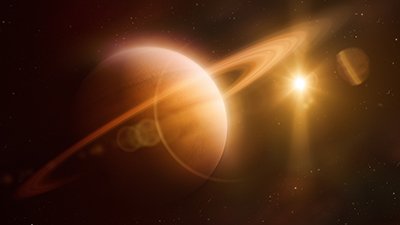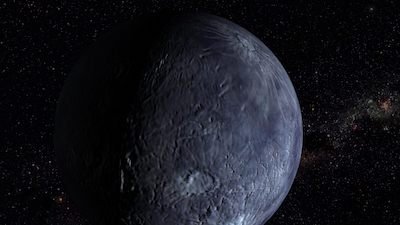
Have Astronomers Found a New Ninth Planet in the Solar System?
Pluto (Again)
Many people were disappointed a decade ago when the International Astronomical Union demoted Pluto from its status as a planet by defining, for the first time, what a planet is. There were at least two reasons that Pluto was removed from the group of objects that we call planets. One reason was that Pluto does not seem to fit with the other planets. Based upon common properties, we easily can group the planets into one of two categories, terrestrial (Earth-like) and Jovian (Jupiter-like) planets. The first four planets, Mercury, Venus, Earth, and Mars, are the terrestrial planets, while the next four, Jupiter, Saturn, Uranus, and Neptune, are the Jovian planets. Pluto’s properties make it difficult to put it into either group. The other reason that Pluto was reclassified from planetary status is that it is very small compared to other planets. This was brought to the forefront in 2003 by the discovery of Eris, another body similar in size to Pluto and with a similar orbit. If Pluto is a planet, then shouldn’t Eris be a planet, too? Eris was just the largest of many small bodies, discovered since 1992, orbiting the sun beyond the orbit of Neptune. More of these likely will be found, so shouldn’t the larger ones of these be planets, too?
The discovery of so many small objects beyond the orbit of Neptune has been motivated by the search for the Kuiper Belt, a hypothetical collection of bodies where short-period comets supposedly come from. Many astronomers call these distant denizens of the solar system Kuiper Belt Objects (KBOs), though some prefer (as I do) the name trans Neptunian objects (TNOs). Astronomers now think that Pluto was just the first TNO discovered, more than seventy years before discovery of the second one. But now many Pluto fans are sure to be encouraged by the January 20, 2016, announcement that two astronomers think that they have evidence that there is a ninth planet after all, a sort of replacement for Pluto.
Discovery of the Outer Planets
To understand this new ninth planet, we ought to review the discovery of planets in the outer solar system. There are five planets that appear as bright stars to the naked eye. In fact, all five are visible in the early morning sky in late January and early February 2016.
Two astronomers think that they have evidence that there is a ninth planet after all, a sort of replacement for Pluto.
These planets have been known since ancient times, which is why our names for them are those of gods in the ancient Roman pantheon. The first modern planet discovery was in 1781, when the German-English astronomer William Herschel (1738–1822) stumbled upon an object while surveying the sky with his telescope. While stars are mere pin points when viewed through a telescope, Herschel could see that this object was a small disk. He thought at first that he was seeing a comet, but after he recorded the motion of the object over several nights, Herschel was able to compute an orbit. He was astonished to learn that it had a circular orbit about twice as far from the sun that Saturn is. This could not be a comet, but rather had to be a planet. It took years for astronomers to decide what to call this new planet, but eventually they decided to follow the custom of naming planets for ancient Roman deities and called it Uranus.
For a half century, Uranus precisely followed its orbit around the sun, required by Newton’s law of gravity. But by the 1840s, there were slight discrepancies between Uranus’ predicted and observed positions. What was causing this? Two mathematicians considered the problem and independently concluded that an eighth planet, out beyond Uranus’ orbit, could account for this. For a few years once each orbital period, the two planets lined up, and the extra gravity of the outer planet tugged on Uranus, altering its orbit slightly. We call these little tugs perturbations. Once astronomers with telescopes looked at the predicted position of this new planet, they easily found it. Following the tradition of naming planets after ancient Roman gods, astronomers soon named this new planet Neptune.
All was well for another half century, but by the end of the nineteenth century some astronomers thought that they saw slight discrepancies in the orbits of Uranus and Neptune, which meant that there might be a ninth planet farther out whose gravity was responsible. However, the situation was a bit different this time—the discrepancies were very small. This meant that the hypothesis of a ninth planet was not well defined, resulting in great uncertainty in its predicted position. This problem caught the fancy of Percival Lowell (1855–1916), an astronomer who had founded his own research observatory in Flagstaff, Arizona, in 1894. Lowell developed techniques to speed the search. He used a special telescope designed to take wide-field photographs of the sky. Astronomers took photographs of the same part of the sky a few nights apart. The stars remained fixed, but any orbital body shifted position on the two photographs. Examining a pair of photographs for any shifting object was laborious. Lowell invented a blink comparator to make it easier, but the work was still tedious. Along the way, Lowell and his assistants discovered many asteroids. The search continued after Lowell’s death. Finally, in 1930, Clyde Tombaugh (1906–1997), a young assistant at Lowell Observatory, found a faint object orbiting beyond Neptune’s orbit. Again, following the custom of naming planets, they chose the Roman god Pluto.
It was the peculiarities in the orbits of some of these TNOs that led to the recent suggestion that there is another body large enough to be a planet beyond the orbit of Neptune.
Almost immediately, astronomers realized that there was a problem. Because it was so faint, Pluto had to be small, probably far too small to account for the gravitational perturbations on the outer planets. However, Pluto’s small mass was not confirmed until 1979 with the discovery of Charon, the largest satellite, or moon, of Pluto. If Pluto could not account for the discrepancies of the orbits of the outer planets, what could? Recall that the discrepancies were very small. Most astronomers now think that the discrepancies merely were errors in measurements of the positions of the outer planets. If so, then there were no real discrepancies to explain. In other words, the discovery of Pluto was a fluke. It was not until the 1980s that astronomers realized that they needed the Kuiper Belt to explain the existence of short period comets, if the solar system were billions of years old. This prompted the reevaluation of Pluto as just one of the larger members of an entire asteroid belt beyond Neptune (TNOs) and, in the 1990s, the search for other members started.
The Ninth Planet Hypothesis
It was the peculiarities in the orbits of some of these TNOs that led to the recent suggestion that there is another body large enough to be a planet beyond the orbit of Neptune. In 2003, astronomers discovered the TNO Sedna. Its average distance from the sun is 524 times the Earth’s distance from the sun. Astronomers define the astronomical unit (AU) to be the average distance between the Earth and sun, so Sedna’s orbit is 524 AU in size. At this distance, it takes Sedna 11,400 years to orbit the sun. Unlike the planets that have nearly circular orbits, TNOs have highly elliptical orbits. Sedna is only 76 AU when closest to the sun (perihelion) and a whopping 936 AU when farthest from the sun (aphelion). Furthermore, the orbital planes of TNOs tend to be more inclined, or tilted, to the orbital planes of the planets. For instance, the inclination of Sedna’s orbit to the Earth’s orbit is nearly twelve degrees; the inclinations of the planets’ orbits are far less than that.
At the time of its discovery, Sedna was the most distant known object in the solar system. However, several other objects that are slightly farther away from the sun are now known. All of them are near their perihelia, so they eventually will move much farther from the sun. It is no accident that these TNOs were found near perihelion, because this is when they appear brightest. Though Sedna is not the most distant object in the solar system right now, its orbit has the greatest known aphelion distance of any object with a reasonably well-defined orbit. Hence, Sedna’s orbit is recognized as the most distant one in the solar system. In 2012, astronomers discovered the object 2012 VP113 (this object has not yet received an official proper name—its discoverers informally call it Biden, for US Vice President Joe Biden, cue to the VP in its designation), though announcement of its discovery was delayed until 2014. The orbit of 2012 VP113 is approximately 260 AU in size, with a perihelion of 80 AU and an aphelion of about 450 AU. Its orbital period is estimated to be 4,300 years.
From God’s Word, we understand that the world is only thousands, not millions, of years old. Therefore, I consider it unlikely that this hypothetical ninth planet exists.
The TNO 2012 VP113 gathered attention, because, while its orbit is different from that of Sedna’s in some respects, the orientation of its perihelion is almost identical to that of Sedna’s. In fact, the handful of the other very distant TNOs now known have perihelia in about the same general place in the solar system as Sedna and 2012 VP113. Though the sample size is admittedly small, one would expect the orbits to be more randomly oriented, but they are not. The probability of this clustering of perihelia by coincidence is very low, so there likely is some reason. In a paper to be published in The Astronomical Journal, two astronomers have proposed a ninth planet as a solution. The gravitational perturbations of the hypothetical ninth planet could accumulate to place these TNOs into this unusual alignment. To do this, the ninth planet would have to have at least ten times the mass of the Earth. Unlike Pluto, this clearly is enough to be considered a planet. It would orbit an average distance of approximately 700 AU from the sun. However, its orbit would be very elliptical, quite unlike any other planet.
Conclusion
Does this planet actually exist? Only time will tell. At such great distance from the sun, it would be extremely faint, requiring the largest telescopes in the world to find it. And, like the search for the previous ninth planet, the location is not well defined, so the search probably would take many years. It is not likely that valuable time on the largest telescopes would be dedicated to this search. It may be that other hypotheses may be developed that will equally explain the data. Or perhaps it is happenstance that these TNOs have such similar perihelia. On the other hand, further discoveries of distant TNOs may have different orbital orientations, thus removing the problem that requires explanation.
One thing that I must note is that this explanation requires millions of years to perturb the TNOs into their orientation. From God’s Word, we understand that the world is only thousands, not millions, of years old. Therefore, I consider it unlikely that this hypothetical ninth planet exists. Publication of this article suggesting a hypothetical ninth planet probably has generated more coverage than it merits. For those who still fret over the loss of Pluto as the ninth planet, this potential new planet could restore the order that they once knew. However, it is likely that with time this story will fade.

Answers in Genesis is an apologetics ministry, dedicated to helping Christians defend their faith and proclaim the good news of Jesus Christ.
- Customer Service 800.778.3390
- Available Monday–Friday | 9 AM–5 PM ET
- © 2026 Answers in Genesis



